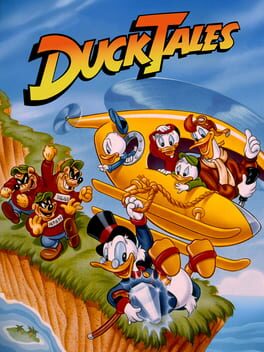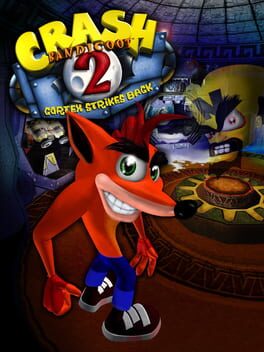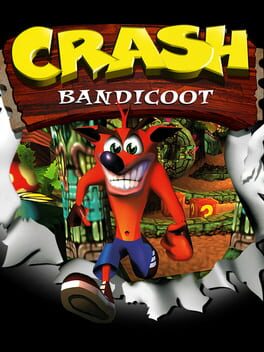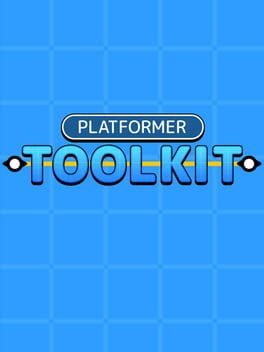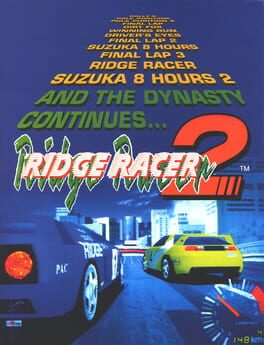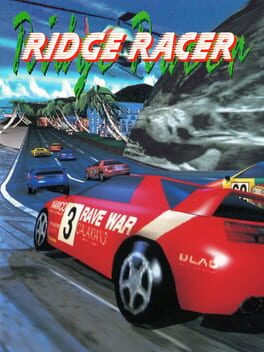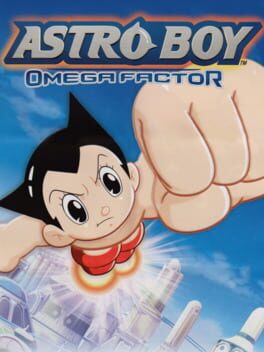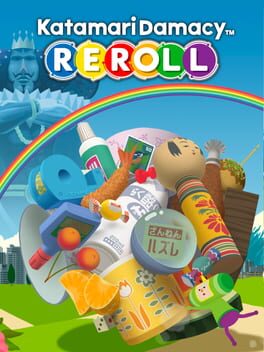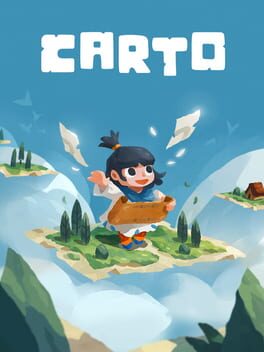Neverwhere
1989
Nothing much too say after replaying this bona fide Capcom classic, except, yeah, it's still good.
It's not a flawless game: it's a bit on the short and easy side when you know what you're doing, the last stage is disappointing, there's a couple of level design flaws (mostly related to the respawning enemies), and why the hell is the first level harder than the rest of the game (or maybe I'm the only one who can't deal with those bees)?
It's still a very good time overall.
There's also something about the kinetism of the pogo stick and the focus on exploration and secrets that makes it feel relatively modern compared to other 8-bit platformers.
It's not a flawless game: it's a bit on the short and easy side when you know what you're doing, the last stage is disappointing, there's a couple of level design flaws (mostly related to the respawning enemies), and why the hell is the first level harder than the rest of the game (or maybe I'm the only one who can't deal with those bees)?
It's still a very good time overall.
There's also something about the kinetism of the pogo stick and the focus on exploration and secrets that makes it feel relatively modern compared to other 8-bit platformers.
The first Crash Bandicoot was a good game only lacking a bit of polish and showing Naughty Dog's inexperience, so it would make sense for the sequel to be a complete slam dunk, right?
Well, it's a bit more complicated since Crash 2 is a case of one step forward, one step back.
First, let's talk about the technical side: it is very impressive for a 1997 Playstation game. Beautiful graphics, shorter loading time,... Naughty Dog really flexed their muscles with that game, starting a reputation for excellence that still holds true nowadays.
Controls have been refined, the weird idiosyncrasies are no more. Analog sticks are now supported, but honestly I still found the digital controls more precise in most cases. Two new moves are also introduced: the slide and the body slam. Sliding is very important since it's used for long jumps, a skill you will need to master if you want to go anywhere in Crash 2. On the other hand, the body slam is a complete dud. It's an obvious nod to Mario's ground pound, except it barely has any use. It's also very slow, and since it's on the same button than the slide you need to make sure of not pushing it by mistake unless you want to see Crash diving belly first inside pits.
Now, what about the levels? Well, first disappointment, the map screen is gone. It is now replaced with boring warp rooms where you can choose your level. At least you'd think it would lead to more thematic variety since you're not stuck to one place. Now there's snow levels (with some of the worst ice physics ever made in video games), sewer levels (yikes), and, err... Oh well. Gimmick levels are back too: the boulder has been replaced by a giant deadly bear, and the hog by a cute polar bear cub (what's with the bears?). I thought they were more difficult and less fun than in the first game. There's also a new gimmick: jet pack levels. Controls are awful, but they're very short so it's not that bad.
Original Crash Bandicoot had strong but very strict level design. The sequel tries to course correct by making it "looser" with less emphasis on timing, more dangerous enemies, and sadly a few cheap deaths. It also gives you a lot of lives, and bonus Aku Aku masks and checkpoints if you die too much, making it "artificially" easier. Issues with perspective and hitboxes have NOT been fixed, which is not acceptable.
I'm being harsh with Crash Bandicoot 2 because it showed the strong promise of fixing everything wrong with the first game, only to fumble it. Lack of polish can only be used as an excuse once.
Well, it's a bit more complicated since Crash 2 is a case of one step forward, one step back.
First, let's talk about the technical side: it is very impressive for a 1997 Playstation game. Beautiful graphics, shorter loading time,... Naughty Dog really flexed their muscles with that game, starting a reputation for excellence that still holds true nowadays.
Controls have been refined, the weird idiosyncrasies are no more. Analog sticks are now supported, but honestly I still found the digital controls more precise in most cases. Two new moves are also introduced: the slide and the body slam. Sliding is very important since it's used for long jumps, a skill you will need to master if you want to go anywhere in Crash 2. On the other hand, the body slam is a complete dud. It's an obvious nod to Mario's ground pound, except it barely has any use. It's also very slow, and since it's on the same button than the slide you need to make sure of not pushing it by mistake unless you want to see Crash diving belly first inside pits.
Now, what about the levels? Well, first disappointment, the map screen is gone. It is now replaced with boring warp rooms where you can choose your level. At least you'd think it would lead to more thematic variety since you're not stuck to one place. Now there's snow levels (with some of the worst ice physics ever made in video games), sewer levels (yikes), and, err... Oh well. Gimmick levels are back too: the boulder has been replaced by a giant deadly bear, and the hog by a cute polar bear cub (what's with the bears?). I thought they were more difficult and less fun than in the first game. There's also a new gimmick: jet pack levels. Controls are awful, but they're very short so it's not that bad.
Original Crash Bandicoot had strong but very strict level design. The sequel tries to course correct by making it "looser" with less emphasis on timing, more dangerous enemies, and sadly a few cheap deaths. It also gives you a lot of lives, and bonus Aku Aku masks and checkpoints if you die too much, making it "artificially" easier. Issues with perspective and hitboxes have NOT been fixed, which is not acceptable.
I'm being harsh with Crash Bandicoot 2 because it showed the strong promise of fixing everything wrong with the first game, only to fumble it. Lack of polish can only be used as an excuse once.
1996
After making some really weird games and a complete shit one (the infamous Way of the Warrior), Naughty Dog finally got their big break with good old Crash here.
It's 1996 and the Playstation is thriving thanks to its adult and teenage audience. But what about the kids? Well, we all know what the kids wanted in the 90's and it was mascot plaformers! So here comes the small team led by Andy Gavin and Jason Rubin (and helped by Universal Interactive's Mark Cerny) and they did a pretty good job selling an alternative to Nintendo's powerhouse Mario 64.
But was Crash Bandicoot actually good? I mean, I played it as a kid, had a fun time for a while, and gave up on the first bridge level.
Well, Crash Bandicoot is a good game. A good game with tons of issues.
Crash Bandicoot's structure is very influenced by another game: Donkey Kong Country. There are three different tropical islands to visit to defeat Dr. Neo Cortex, and if you want the true ending you need to achieve 100% completion (it's tough!). It's a visually vibrant and coherent game, but on the other hand it lacks variety. There are basically three different kinds of environments (jungle, temples, and Cortex's buildings) which can get a bit old.
Crash himself controls pretty well, despite the lack of analog. He's got a few idiosyncrasies though, and combined with the bad depth perception and some weird hitbox, the game feels jankier than it should be.
On the other hand, level design feels very tight. Well, almost too tight and clockwork-like honestly. There is an over-reliance on timing platforming. It sometimes results in a bad flow where you've got to stop at every obstacle and even rely on trial and error to figure the hardest timings. Naughty Dog's famous set pieces (here it's the boulder and hog levels) bring much-needed variety.
The most common problem people have with this game is the difficulty. It's not that the whole thing is painfully difficult, but there's weird difficulty spikes here and there like jumps with a very short window, or levels just way too long. It really feels like it was made by developers new at platformers in that aspect.
It doesn't help that the saving system is awful and one of the weirdest I've ever seen in a game. It's almost a minigame to figure it out (you can only save your progression if you beat bonus levels or get a gem, but your level progression and gem count are tracked differently,...) (why). It's not too bad since continues are infinite and the game is very generous with lifes, but coupled to the difficulty it will certainly discourage the weakest players (like 10 years old me in the past).
Yeah... That's a lot of issues. But it's still a good game! A good game with a ton of flaws and an obvious lack of polish.
It's 1996 and the Playstation is thriving thanks to its adult and teenage audience. But what about the kids? Well, we all know what the kids wanted in the 90's and it was mascot plaformers! So here comes the small team led by Andy Gavin and Jason Rubin (and helped by Universal Interactive's Mark Cerny) and they did a pretty good job selling an alternative to Nintendo's powerhouse Mario 64.
But was Crash Bandicoot actually good? I mean, I played it as a kid, had a fun time for a while, and gave up on the first bridge level.
Well, Crash Bandicoot is a good game. A good game with tons of issues.
Crash Bandicoot's structure is very influenced by another game: Donkey Kong Country. There are three different tropical islands to visit to defeat Dr. Neo Cortex, and if you want the true ending you need to achieve 100% completion (it's tough!). It's a visually vibrant and coherent game, but on the other hand it lacks variety. There are basically three different kinds of environments (jungle, temples, and Cortex's buildings) which can get a bit old.
Crash himself controls pretty well, despite the lack of analog. He's got a few idiosyncrasies though, and combined with the bad depth perception and some weird hitbox, the game feels jankier than it should be.
On the other hand, level design feels very tight. Well, almost too tight and clockwork-like honestly. There is an over-reliance on timing platforming. It sometimes results in a bad flow where you've got to stop at every obstacle and even rely on trial and error to figure the hardest timings. Naughty Dog's famous set pieces (here it's the boulder and hog levels) bring much-needed variety.
The most common problem people have with this game is the difficulty. It's not that the whole thing is painfully difficult, but there's weird difficulty spikes here and there like jumps with a very short window, or levels just way too long. It really feels like it was made by developers new at platformers in that aspect.
It doesn't help that the saving system is awful and one of the weirdest I've ever seen in a game. It's almost a minigame to figure it out (you can only save your progression if you beat bonus levels or get a gem, but your level progression and gem count are tracked differently,...) (why). It's not too bad since continues are infinite and the game is very generous with lifes, but coupled to the difficulty it will certainly discourage the weakest players (like 10 years old me in the past).
Yeah... That's a lot of issues. But it's still a good game! A good game with a ton of flaws and an obvious lack of polish.
2022
Pretty interesting idea! Would be nice to see more interactive game design "essays" like this.
Well, to be honest, I was already fine with default controls. I've played plenty of shitty 8-bits platformers with worse controls and had fun mastering them.
It's also kinda backwards to have to change the character to fit the level design instead of the reverse... But yeah, it's about game character control, not level design.
Well, to be honest, I was already fine with default controls. I've played plenty of shitty 8-bits platformers with worse controls and had fun mastering them.
It's also kinda backwards to have to change the character to fit the level design instead of the reverse... But yeah, it's about game character control, not level design.
2022
1994
Despite the name, it's not a sequel but an update to the first game. Well, it's not the weirdest thing for arcade games, Sega did way worse with After Burner II.
So, what are the changes?
- There's a rear mirror. You can use it to block the other cars, I guess. Driving well seems like a more effective strategy to me.
- Default car is now a blue Solvalou. It still drives the same than in the first game. It's basically a skin that the operator can change in the dip switches.
- There's a few graphical updates and a more pleasing UI.
- Course is the same, but there's now a helicopter flying above the race track. Cool! (they added it later to the original Ridge Racer Playstation port).
- A brand-new soundtrack: six new songs (including one of my favorite in the series, Grip) and five remixes from the first game.
- And probably the real reason for that update, Ridge Racer 2 introduced a linked multiplayer mode. It was after all one of the key features of Sega's "Ridge Racer killer", Daytona USA, and Namco had to answer back.
To sum up, it's Ridge Racer but slightly better. That's it.
So, what are the changes?
- There's a rear mirror. You can use it to block the other cars, I guess. Driving well seems like a more effective strategy to me.
- Default car is now a blue Solvalou. It still drives the same than in the first game. It's basically a skin that the operator can change in the dip switches.
- There's a few graphical updates and a more pleasing UI.
- Course is the same, but there's now a helicopter flying above the race track. Cool! (they added it later to the original Ridge Racer Playstation port).
- A brand-new soundtrack: six new songs (including one of my favorite in the series, Grip) and five remixes from the first game.
- And probably the real reason for that update, Ridge Racer 2 introduced a linked multiplayer mode. It was after all one of the key features of Sega's "Ridge Racer killer", Daytona USA, and Namco had to answer back.
To sum up, it's Ridge Racer but slightly better. That's it.
1993
The original Playstation killer app and the start of Namco's impressive track record on Sony's console. While it wasn't really "arcade at home", it was an incredible showcase for 3D gaming in late 94 when the competition were stuck with Virtua Racing and Stunt Race FX.
Honestly, it's still a fantastic entry in the series. People complaining about how short it is don't realize how barebone the original arcade game was. This Playstation port is full of bonus content: 12 different cars to choose (4 at the start + 8 hidden), a reverse "extra" course to unlock (sure, it's the same course backwards, but you still have to "relearn" it to beat it), and an hidden boss car you need to beat to unlock (a staple in the series).
Having different cars to drive is quite the jump from just one, especially since they all have their different characteristics. The driving model has been tweaked compared to the original. Drifting is harder to pull off and a bad turn can send you to the shadow realm after too much oversteering. I'd advice to use drifts wisely to limit risks. Another tip is to use a very fast car with low grip: you only need to step off the gas a little and quickly accelerate again to start drifting, which is way more manageable than by using the brakes.
Graphically it does the job (keeping in mind it was a Playstation launch title, of course). It's the exact same course as in the arcade version, and they even added a helicopter flying around! The only issue is the poor visibility during the night driving parts, better know the track very well because you can't see anything.
Soundtrack is still as good as in the arcade version. If you're playing on original hardware there's even a disc swapping trick to play your own songs! I used to do that quite often as a kid for the novelty.
Ridge Racer is an excellent port: more content, and with harder and more nuanced driving. A clear leap over the original.
Honestly, it's still a fantastic entry in the series. People complaining about how short it is don't realize how barebone the original arcade game was. This Playstation port is full of bonus content: 12 different cars to choose (4 at the start + 8 hidden), a reverse "extra" course to unlock (sure, it's the same course backwards, but you still have to "relearn" it to beat it), and an hidden boss car you need to beat to unlock (a staple in the series).
Having different cars to drive is quite the jump from just one, especially since they all have their different characteristics. The driving model has been tweaked compared to the original. Drifting is harder to pull off and a bad turn can send you to the shadow realm after too much oversteering. I'd advice to use drifts wisely to limit risks. Another tip is to use a very fast car with low grip: you only need to step off the gas a little and quickly accelerate again to start drifting, which is way more manageable than by using the brakes.
Graphically it does the job (keeping in mind it was a Playstation launch title, of course). It's the exact same course as in the arcade version, and they even added a helicopter flying around! The only issue is the poor visibility during the night driving parts, better know the track very well because you can't see anything.
Soundtrack is still as good as in the arcade version. If you're playing on original hardware there's even a disc swapping trick to play your own songs! I used to do that quite often as a kid for the novelty.
Ridge Racer is an excellent port: more content, and with harder and more nuanced driving. A clear leap over the original.
1993
Back to the origins of the best arcade racer series (sorry Sega fans): it was a brain-melting technological marvel in 1993, and this System 22 version still impresses compared to the Playstation port.
The main issue with Ridge Racer nowadays is pretty obvious. There's only one car (the F/A Racing) and one course (later known as Seaside Route 765). You can choose between four races: novice (two laps), intermediate (three laps), advanced (three laps on an extended version of the track) and T.T. (not really a time trial but a 1-on-1 with a rival on the advanced track). Every race is faster than the last one, kinda like going from 50 to 100 and 150cc in Mario Kart. This is an extremely short game, but it makes sense when you see it as a replayable ride.
So, how does it play? Well, it's a smooth racing game with simple but very fun to master drifting mechanics. While turning at high speed, let go of the gas pedal, tap the brakes, and then accelerate. You'll start sliding gracefully on the road without losing too much speed. There's a couple of turns where drifting is imperative.
AI is very simple. The other cars are merely obstacles, their main purpose being to obstruct your driving line. There's an exception though: a yellow Solvalou which acts as a "rival" car. It can be a bit of a pain in advanced difficulty, since its speed varies greatly from "obviously waiting for you" to "so fast I'll soon break the laws of physics". Probably some kind of weird rubberbanding going on, but if you don't make mistakes it's definitely beatable.
Last but not least: the soundtrack. There's between six different songs to choose, all pumping electronic music tracks. It was probably a shock for a lot of people back then to hear gabber in a video game. Well, it sure was for me when I was a kid!
Did I enjoy replaying the original Ridge Racer in 2022 as much as in the 90s'? Hell yeah, I did! But it took me 30 minutes to beat all the races so it was a short pleasure.
The main issue with Ridge Racer nowadays is pretty obvious. There's only one car (the F/A Racing) and one course (later known as Seaside Route 765). You can choose between four races: novice (two laps), intermediate (three laps), advanced (three laps on an extended version of the track) and T.T. (not really a time trial but a 1-on-1 with a rival on the advanced track). Every race is faster than the last one, kinda like going from 50 to 100 and 150cc in Mario Kart. This is an extremely short game, but it makes sense when you see it as a replayable ride.
So, how does it play? Well, it's a smooth racing game with simple but very fun to master drifting mechanics. While turning at high speed, let go of the gas pedal, tap the brakes, and then accelerate. You'll start sliding gracefully on the road without losing too much speed. There's a couple of turns where drifting is imperative.
AI is very simple. The other cars are merely obstacles, their main purpose being to obstruct your driving line. There's an exception though: a yellow Solvalou which acts as a "rival" car. It can be a bit of a pain in advanced difficulty, since its speed varies greatly from "obviously waiting for you" to "so fast I'll soon break the laws of physics". Probably some kind of weird rubberbanding going on, but if you don't make mistakes it's definitely beatable.
Last but not least: the soundtrack. There's between six different songs to choose, all pumping electronic music tracks. It was probably a shock for a lot of people back then to hear gabber in a video game. Well, it sure was for me when I was a kid!
Did I enjoy replaying the original Ridge Racer in 2022 as much as in the 90s'? Hell yeah, I did! But it took me 30 minutes to beat all the races so it was a short pleasure.
2020
There's the embryo of a very good game, but it's not quite there yet.
You're walking on those randomly generated islands, and sometimes you find interesting sceneries (a forest of monoliths under the rain, a pink islet under a giant crescent sun,...), but it quickly becomes samey. Photography is simple and nice, tilting manually the camera to get into portrait mode feels kinda awkward though.
And... That's it. It's cute and relaxing but there's nothing more to it.
You're walking on those randomly generated islands, and sometimes you find interesting sceneries (a forest of monoliths under the rain, a pink islet under a giant crescent sun,...), but it quickly becomes samey. Photography is simple and nice, tilting manually the camera to get into portrait mode feels kinda awkward though.
And... That's it. It's cute and relaxing but there's nothing more to it.
There's two things I'm looking at when I'm picking up a licensed game: does it provide nice fanservice, and is it, you know, actually good to play? There's games like Batman on NES which are fantastic but don't do much (or anything at all) with their license. On the other hand, there's stuff like JoJo's All Star Battle. It's a bad fighting game (especially compared to the Capcom ones), but the dedication to its original material makes it a must play for fans.
And sometimes, the holy grail appears: a great game on its own merit, but also able to make the original work shine.
A game like Astro Boy: Omega Factor.
Despite being released during the broadcast of the 2003 anime remake, Omega Factor is not a direct tie-in. It's a completely original game directed and written by Segagaga's creator, Tetsu Okano.
Okano (who will also direct Black Jack on the DS) wrote a love letter to Tezuka. Omega Factor makes perfect use of Tezuka's Star System: Tezuka considered his characters as actors he could use in his manga and anime in different roles. Omega Factor doesn't only use Astro Boy characters, but makes full use of Tezuka's cast. You can find Black Jack, Rock, Unico, Sapphire, the Fumoon, Sharaku, the Wonder Three, Acetylene Lamp,... Some are main characters, others are cameos hidden in the stages, but the Star System is also directly tied to the game mechanics: by meeting new characters, Astro will progressively unlock his Omega Factor and upgrade his powers (you can choose which abilities you want to upgrade). Meeting everyone is also how you unlock the true end.
As for the story itself, well... It's pretty good. There's a few neat plot twists and a lot of fun set pieces for fans like fighting Deadcross on the Marine Express, dueling the Blue Knight, or battling World's Strongest Robots one by one. Even the level title screens are modeled on Tezuka manga covers.
The game itself was handled by Treasure with veterans Mitsuru Yaida and Naoki Kitagawa at the helm. It's a single plan beat'em up with shmup sections and a strong emphasis on boss fights (as often with Treasure). You've got a basic punch combo, a kick you can use to make enemies barrel into other foes, and a small laser beam. There's also two main mechanics that make the game incredibly enjoyable: dashing and special attacks.
By double tapping a direction, Astro can use his jet boots to propel himself. The key thing is that the dash makes you invincible, so timing it properly is essential to avoid attacks.
Astro also has a special attack bar and you gain meter when attacking like in a fighting game. There's three different special attacks, using one bar each: a dash/punch combo, a huge beam attack (perfect for dealing big damage), and a machine gun attack. That machine gun attack can be a massive game changer: it hits all screen, stuns the enemies, and gives you invincibility! You can use it like a bomb in an arcade game to get out of sticky situations.
It's a tightly designed game where choosing the right move at the right time is important and you'll lose very quickly if you don't think about the enemy patterns (unless you're playing on easy of course).
Astro Boy: Omega Factor isn't flawless. It's a bit repetitive since stages are meant to be replayed by design. Level design is basic: there's a very short platforming section and it doesn't work at all since gameplay is all about combat. It's not a technical masterpiece either. It looks great, but there's some very annoying slowdowns.
It's still a fantastic game and one of the best thing to play on GBA.
And sometimes, the holy grail appears: a great game on its own merit, but also able to make the original work shine.
A game like Astro Boy: Omega Factor.
Despite being released during the broadcast of the 2003 anime remake, Omega Factor is not a direct tie-in. It's a completely original game directed and written by Segagaga's creator, Tetsu Okano.
Okano (who will also direct Black Jack on the DS) wrote a love letter to Tezuka. Omega Factor makes perfect use of Tezuka's Star System: Tezuka considered his characters as actors he could use in his manga and anime in different roles. Omega Factor doesn't only use Astro Boy characters, but makes full use of Tezuka's cast. You can find Black Jack, Rock, Unico, Sapphire, the Fumoon, Sharaku, the Wonder Three, Acetylene Lamp,... Some are main characters, others are cameos hidden in the stages, but the Star System is also directly tied to the game mechanics: by meeting new characters, Astro will progressively unlock his Omega Factor and upgrade his powers (you can choose which abilities you want to upgrade). Meeting everyone is also how you unlock the true end.
As for the story itself, well... It's pretty good. There's a few neat plot twists and a lot of fun set pieces for fans like fighting Deadcross on the Marine Express, dueling the Blue Knight, or battling World's Strongest Robots one by one. Even the level title screens are modeled on Tezuka manga covers.
The game itself was handled by Treasure with veterans Mitsuru Yaida and Naoki Kitagawa at the helm. It's a single plan beat'em up with shmup sections and a strong emphasis on boss fights (as often with Treasure). You've got a basic punch combo, a kick you can use to make enemies barrel into other foes, and a small laser beam. There's also two main mechanics that make the game incredibly enjoyable: dashing and special attacks.
By double tapping a direction, Astro can use his jet boots to propel himself. The key thing is that the dash makes you invincible, so timing it properly is essential to avoid attacks.
Astro also has a special attack bar and you gain meter when attacking like in a fighting game. There's three different special attacks, using one bar each: a dash/punch combo, a huge beam attack (perfect for dealing big damage), and a machine gun attack. That machine gun attack can be a massive game changer: it hits all screen, stuns the enemies, and gives you invincibility! You can use it like a bomb in an arcade game to get out of sticky situations.
It's a tightly designed game where choosing the right move at the right time is important and you'll lose very quickly if you don't think about the enemy patterns (unless you're playing on easy of course).
Astro Boy: Omega Factor isn't flawless. It's a bit repetitive since stages are meant to be replayed by design. Level design is basic: there's a very short platforming section and it doesn't work at all since gameplay is all about combat. It's not a technical masterpiece either. It looks great, but there's some very annoying slowdowns.
It's still a fantastic game and one of the best thing to play on GBA.
2008
One of the few RPG Maker game worth playing, next to Yume Nikki and Space Funeral (it sounds like I hate RPG Maker games, but on the contrary, I've played way too much of them).
Neat art, good soundtrack, basic combat, and decent puzzles,... But I guess the main appeal is the writing. While the meta-aspects and commentary on violence feels a bit hackneyed nowadays, there's still nothing else like OFF's surrealist capitalistic hellscapes and its weird brand of nihilism.
Neat art, good soundtrack, basic combat, and decent puzzles,... But I guess the main appeal is the writing. While the meta-aspects and commentary on violence feels a bit hackneyed nowadays, there's still nothing else like OFF's surrealist capitalistic hellscapes and its weird brand of nihilism.
Reroll is an excellent way to (re)discover Keita Takahashi's first game.
The original Katamari Damacy was Takahashi making a statement about his idea of "fun". A sandbox video game, but in the real sense of the word, not as some open world shooty collect-a-thon thing. He gives the player a simple toy (the ball and its rolling mechanics) and lets the player use it like on a playground. There's still a lot of concessions made towards traditional video game "tropes" like levels, time limits, failure states,... But it's already a step towards the ideal he'll eventually reach with Noby Noby Boy.
It's a game that aged like fine wine. The art, writing, and soundtrack are still incredible. The only reason I'm not giving it a perfect score is because of the two troll levels (Taurus and Ursa Major): I see the humour, but man, it wasn't fun.
A must play.
The original Katamari Damacy was Takahashi making a statement about his idea of "fun". A sandbox video game, but in the real sense of the word, not as some open world shooty collect-a-thon thing. He gives the player a simple toy (the ball and its rolling mechanics) and lets the player use it like on a playground. There's still a lot of concessions made towards traditional video game "tropes" like levels, time limits, failure states,... But it's already a step towards the ideal he'll eventually reach with Noby Noby Boy.
It's a game that aged like fine wine. The art, writing, and soundtrack are still incredible. The only reason I'm not giving it a perfect score is because of the two troll levels (Taurus and Ursa Major): I see the humour, but man, it wasn't fun.
A must play.
2020
It's one of those indie game where the main interest is exploring a great and unique gimmick. I'd say Carto does quite well on that side, the map mechanics are really neat.
As a pure puzzle game, I'm more conflicted. Puzzles are usually quite simple, except in some cases where it's so vague you've got no idea what you're supposed to do (and there's no hint whatsoever). It's too boring for good puzzlers and sometimes frustrating for casual players, the worst of both worlds.
I was surprised by how much story and dialogues there was (even though the main character is mute). The writing is cute and humorous but I didn't care much about the story or characters, except for the friendship between Carto and Shianan.
As a pure puzzle game, I'm more conflicted. Puzzles are usually quite simple, except in some cases where it's so vague you've got no idea what you're supposed to do (and there's no hint whatsoever). It's too boring for good puzzlers and sometimes frustrating for casual players, the worst of both worlds.
I was surprised by how much story and dialogues there was (even though the main character is mute). The writing is cute and humorous but I didn't care much about the story or characters, except for the friendship between Carto and Shianan.
1984
Published by the American branch of Telenet Japan, Renovation Products, this Mega CD port of Ninja Hayate is weirdly US exclusive despite the traditional Japan theme. Like the classic Time Gal (another Taito game), and Data East's Road Avenger and Cobra Command, Revenge of the Ninja was ported by Wolf Team. It's another very competent job, even if the game itself is more forgettable than the others.
If you're not familiar with that style of interactive movies, it's basically a QTE game. You've got button prompts appearing on the screen (here's it's the four directions and an action button), and if you don't press it in time, say goodbye to one life. It sounds simple but you'll probably need some memorization to beat Revenge of the Ninja since the timing is quite strict. It took me a while to figure it out and I almost gave up, but after playing a bit more it suddenly clicked and I managed to beat it. Well it's quite short after all, there's 19 "levels" (scenes would be more appropriate) but some end very quickly. If you want a real challenge there's also a hard mode that disables the button prompts (yeah, screw that).
The original Laserdisc game was animated by Toei and it looks good even after being butchered by the Mega CD video compression. There's a bit of a Lupin the Third influence with its goofy ninja protagonist infiltrating an evil castle and barely staying alive, but compared to the inventiveness of Time Gal or the hectic first-person action of Road Avenger, it's quite dull. Wolf Team did improve it by adding music (composed by Shinji Tamura) since the original arcade version had none!
A decent FMV game, but not the most exciting offering in an already very niche genre.
If you're not familiar with that style of interactive movies, it's basically a QTE game. You've got button prompts appearing on the screen (here's it's the four directions and an action button), and if you don't press it in time, say goodbye to one life. It sounds simple but you'll probably need some memorization to beat Revenge of the Ninja since the timing is quite strict. It took me a while to figure it out and I almost gave up, but after playing a bit more it suddenly clicked and I managed to beat it. Well it's quite short after all, there's 19 "levels" (scenes would be more appropriate) but some end very quickly. If you want a real challenge there's also a hard mode that disables the button prompts (yeah, screw that).
The original Laserdisc game was animated by Toei and it looks good even after being butchered by the Mega CD video compression. There's a bit of a Lupin the Third influence with its goofy ninja protagonist infiltrating an evil castle and barely staying alive, but compared to the inventiveness of Time Gal or the hectic first-person action of Road Avenger, it's quite dull. Wolf Team did improve it by adding music (composed by Shinji Tamura) since the original arcade version had none!
A decent FMV game, but not the most exciting offering in an already very niche genre.
2021
